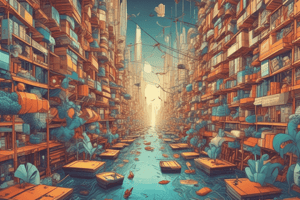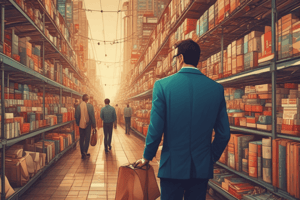Podcast
Questions and Answers
What is the leakage in the Government Sector?
What is the leakage in the Government Sector?
- Government spending
- Taxation (correct)
- Exports
- Imports
What is the term for the total value of goods produced and services provided in a country during one year?
What is the term for the total value of goods produced and services provided in a country during one year?
- Gross National Product
- Net Domestic Product
- Gross Domestic Product (correct)
- Net National Product
What is the point where the demand and supply curves intersect?
What is the point where the demand and supply curves intersect?
- Market equilibrium (correct)
- Under-demand
- Over-supply
- Disequilibrium
Which of the following can cause shifts in the demand and supply curves?
Which of the following can cause shifts in the demand and supply curves?
What type of market involves the buying and selling of goods and services directly to consumers?
What type of market involves the buying and selling of goods and services directly to consumers?
What type of market determines wages and employment levels?
What type of market determines wages and employment levels?
What is the primary difference between retail markets and labour markets?
What is the primary difference between retail markets and labour markets?
What is the economic problem that defines scarcity?
What is the economic problem that defines scarcity?
What happens to prices during a recession?
What happens to prices during a recession?
What is the impact of government intervention in technology on the market?
What is the impact of government intervention in technology on the market?
What is an example of a leakage in the Household Sector?
What is an example of a leakage in the Household Sector?
What is an example of an injection in the Firms Sector?
What is an example of an injection in the Firms Sector?
What is the primary role of the Household Sector in the economy?
What is the primary role of the Household Sector in the economy?
What is the impact of an economic boom on the economy?
What is the impact of an economic boom on the economy?
Flashcards are hidden until you start studying
Study Notes
Markets and Economy
- Retail markets involve selling goods and services to consumers, while labor markets deal with the exchange of work for wages between workers and employers.
- Retail dynamics are driven by consumer behavior and competition, whereas factors like supply, demand, and government policies influence labor markets.
- Both retail markets and labor markets are critical to the economy, playing important roles.
Economic Problem and Scarcity
- The economic problem is defined as scarcity, where the demand for a good or service is greater than the supply of the good or service.
Economic Boom and Recession
- During an economic boom, there is growth, job creation, and rising prices, while during a recession, the economy shrinks, jobs are lost, and prices might fall.
- Governments often intervene to stabilize the economy during both booms and recessions.
Government Intervention in Technology
- Government involvement in technology can change how things work in the market, by making rules about data handling or investing in new ideas.
- This can affect how businesses operate and how people access technology, potentially creating new opportunities in the market.
Sectors of the Economy
- Household Sector: includes individuals and families who consume goods and services and receive income from working.
- Firms Sector: includes businesses that produce goods and services and generate income by selling them.
Leakage and Injections
- Leakage: money that leaves the economy or is not spent, decreasing the money flow.
- Injection: income that is spent within the economy, increasing the money flow.
- Examples of leakage and injection in different sectors:
- Household Sector: leakage (saving money), injection (income - wages, rent, interest, profit)
- Firms Sector: leakage (savings by businesses), injection (investments by firms)
- Financial Sector: leakage (taxations), injection (investments)
- Government Sector: leakage (taxation), injection (government spending)
- Overseas Sector: leakage (imports), injection (exports)
Gross Domestic Product (GDP)
- GDP is the total value of goods produced and services provided in a country during one year.
- Economic growth is measured by the percentage change in GDP.
Equilibrium
- Market equilibrium is the situation where the quantity supplied and the quantity demanded of a particular product are equal.
- Equilibrium occurs at the point where the demand and supply curves intersect.
- Changes to equilibrium can result from:
- Shifts in the demand and supply curves
- Changes to the level of efficiency in the production process
- Changes to the cost of production
- Change in the number of suppliers
- Expected future prices
- Climatic conditions
Studying That Suits You
Use AI to generate personalized quizzes and flashcards to suit your learning preferences.




